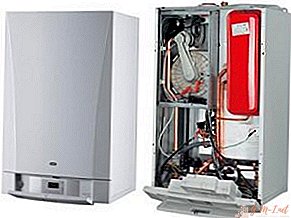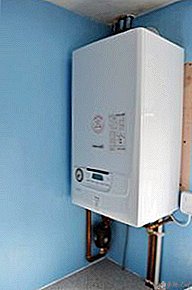 To maintain the heat in the room, it is more profitable to use gas boilers than central heating, however, the installation of such equipment in the apartment is often impossible. This problem is solved by the parapet boiler, which will help to significantly save on paying bills.
To maintain the heat in the room, it is more profitable to use gas boilers than central heating, however, the installation of such equipment in the apartment is often impossible. This problem is solved by the parapet boiler, which will help to significantly save on paying bills.
What is a parapet boiler
 A parapet boiler is a device whose main function is to heat water to heat a room. If it is almost impossible to install a conventional gas boiler in an apartment: in multi-apartment buildings there is often no gas duct, then the characteristics of the parapet boiler allow it to work in almost any room. In addition, it does not burn the surrounding oxygen, which is critical for an ordinary apartment with not the best ventilation. Thanks to the smoke exhaust system, the use of such a device is absolutely safe.
A parapet boiler is a device whose main function is to heat water to heat a room. If it is almost impossible to install a conventional gas boiler in an apartment: in multi-apartment buildings there is often no gas duct, then the characteristics of the parapet boiler allow it to work in almost any room. In addition, it does not burn the surrounding oxygen, which is critical for an ordinary apartment with not the best ventilation. Thanks to the smoke exhaust system, the use of such a device is absolutely safe.
The power of the device varies from 15 to 45 kilowatts, depending on the model. Basically, the boiler is chosen taking into account the heated area and other factors.
Design and main characteristics of the parapet boiler
There are several types of parapet boilers, the following classification will help you choose the right model:
- installation method: floor and wall, left and right;
- by the number of circuits: single and double circuits;
- by the presence of automation: energy dependent or not.
A few words about the second classification. Single-circuit boilers perform only one function - space heating; double-circuit, in addition, heat the water. Special convection openings are provided in the device's casing, which allow maintaining heat in the room without installing additional radiators.
The parapet boiler can operate both with the help of a portable cylinder, and from a conventional gas pipeline. The body of the device is made of steel; the minimum thickness is 3 mm, and a special powder coating prevents rust, even if the boiler is in the kitchen, where there is usually high humidity.
The parapet boiler consists of the following parts:
- steel cases;

- closed combustion chamber;
- pilot burner block, piezo ignition and thermocouple;
- exhaust systems in the form of a coaxial chimney facing the street;
- heat exchanger;
- electrical sensors that monitor the operation of the device.
The chimney allows you to collect combustion air not from the room, but from the street. Combustion products stand out from the apartment. Safety is ensured by the operation of the following components: thermometer, thermocouple and traction sensor.
IMPORTANT! You do not need to install a parapet boiler yourself, leave it to specialists.
The principle of operation of the parapet boiler
When buying a non-volatile boiler, turn on the device using the piezo ignition button. If the device is volatile, then automation automatically turns it on. In Russia, boilers of the first type are common.
So, the parapet boiler works as follows. First, the ignitor ignites the main burner, which heats the water circulating in the heat exchanger. As soon as the water temperature reaches the required level, the burner automatically stops working. After some time, the temperature of the coolant decreases again, and the igniter once again ignites the burner.
REFERENCE! All information about the operation of the boiler, its power, etc. should be sought in the instructions.
Pros and cons of the parapet boiler
The advantages of a parapet boiler are:
- equipment can be installed in any room, including the apartment;

- unlike gas boilers, the device is inexpensive;
- small dimensions, allowing you to install the boiler in almost any room;
- there is no need to install additional equipment in the form of radiators;
- A large selection of devices with different performance.
To choose the right power, you need to apply a simple formula: 2 kW per 10 square meters of heated area.
Nevertheless, a number of problems are associated with such equipment. For example, if you do not conduct regular maintenance of the device, you may not notice how the thermoplastic that connects the boiler parts gradually ceases to be airtight, that is, it begins to let carbon monoxide and other substances poisonous to humans into the room. All this can lead to poisoning of the inhabitants of the apartment.
Another problem that owners of parapet boilers face is a coaxial chimney, which in budget models is made of ordinary steel, whereas, according to the rules of operation, it should only be made of stainless steel. So, in cheap models, soot and condensate often accumulate in the chimney, creating a chemically active environment. Gradually, the steel begins to corrode, and combustion products enter the air coming from the street to the burner. At the same time, for the normal functioning of the device oxygen is not enough, and the performance of the device decreases. In addition, soot enters the boiler body, thereby causing corrosion.
The chimney brings with it another problem: gusts of wind can blow out the flame inside the burner. In this regard, when installing the device, it is necessary to provide protection against the wind. The last drawback of the equipment is its low power: such a device is hardly suitable for maintaining heat in a large room.
So, for a small apartment, a parapet boiler is an excellent alternative to central heating or other heating appliances.



Leave Your Comment